Managing International Business: Cultural Similarities and Differences
VerifiedAdded on 2023/06/08
|12
|1627
|171
AI Summary
This report analyses the cultural similarities and differences between China, Chile, Norway, and Australia using Hofstede's cultural dimensions. It also provides recommendations for Huawei's expansion from China to Chile.
Contribute Materials
Your contribution can guide someone’s learning journey. Share your
documents today.

Running head: MANAGING INTERNATIONAL BUSINESS
MANAGING INTERNATIONAL BUSINESS
Name of the student
Name of the University
Author Notes
MANAGING INTERNATIONAL BUSINESS
Name of the student
Name of the University
Author Notes
Secure Best Marks with AI Grader
Need help grading? Try our AI Grader for instant feedback on your assignments.
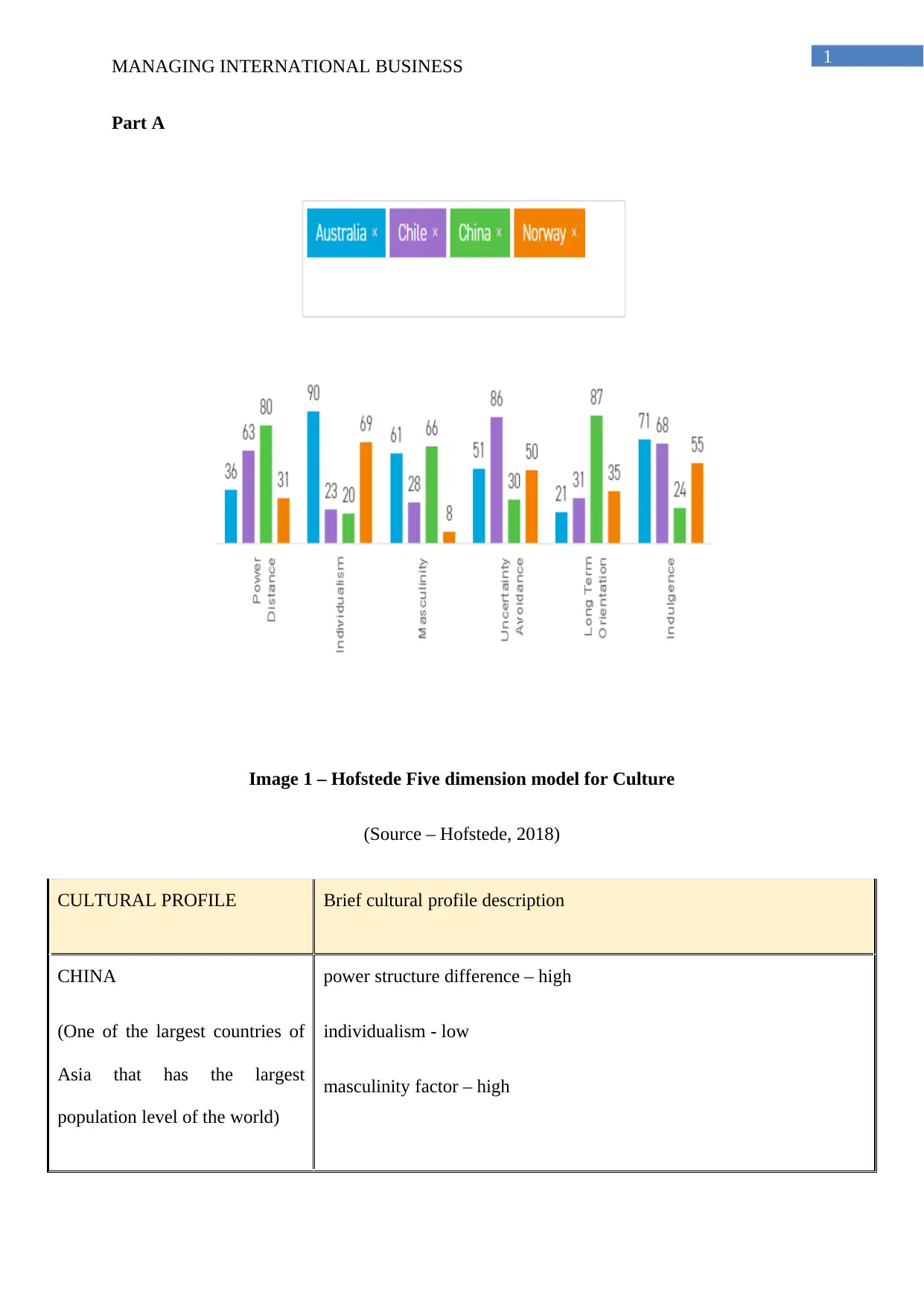
1
MANAGING INTERNATIONAL BUSINESS
Part A
Image 1 – Hofstede Five dimension model for Culture
(Source – Hofstede, 2018)
CULTURAL PROFILE Brief cultural profile description
CHINA
(One of the largest countries of
Asia that has the largest
population level of the world)
power structure difference – high
individualism - low
masculinity factor – high
MANAGING INTERNATIONAL BUSINESS
Part A
Image 1 – Hofstede Five dimension model for Culture
(Source – Hofstede, 2018)
CULTURAL PROFILE Brief cultural profile description
CHINA
(One of the largest countries of
Asia that has the largest
population level of the world)
power structure difference – high
individualism - low
masculinity factor – high
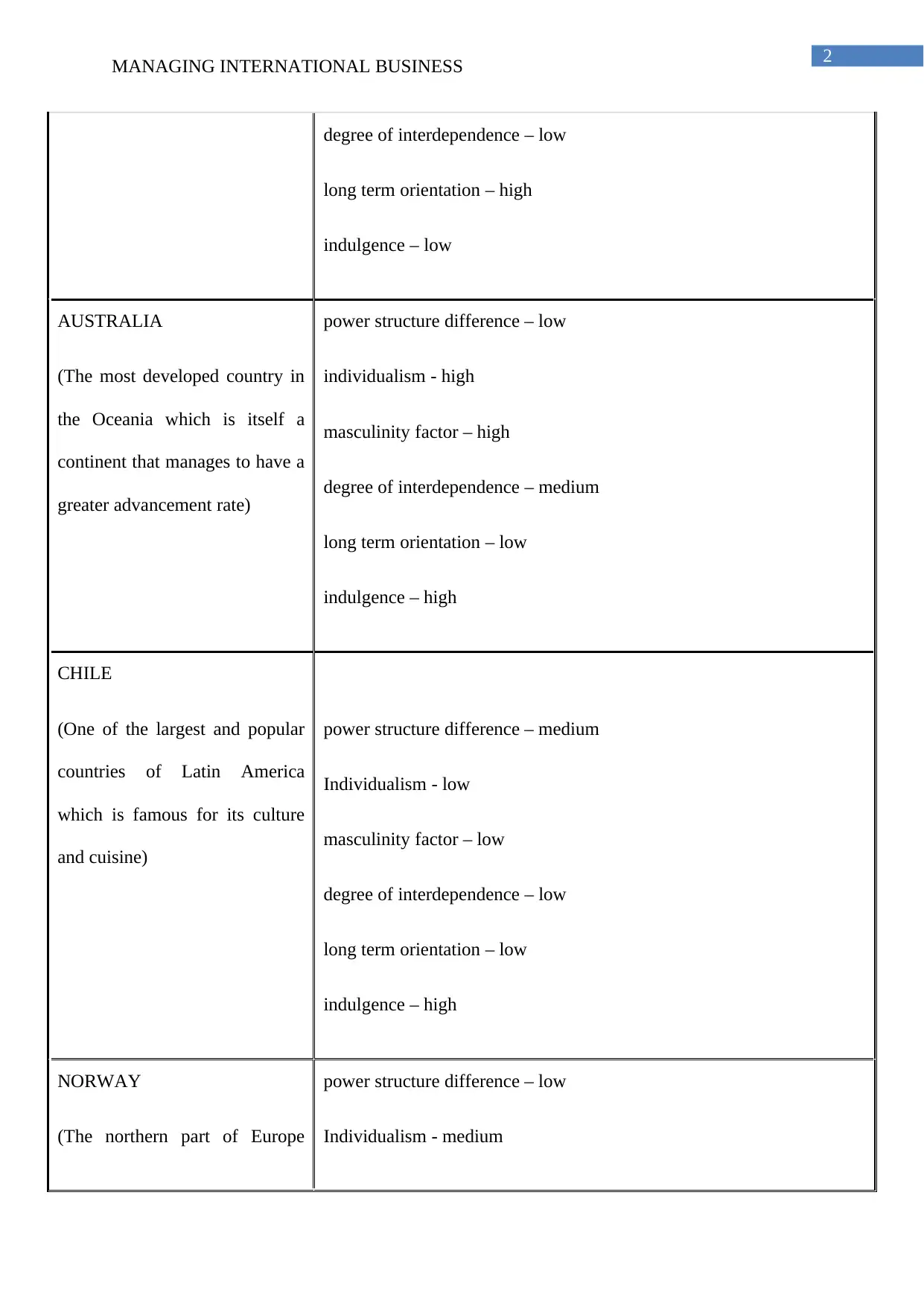
2
MANAGING INTERNATIONAL BUSINESS
degree of interdependence – low
long term orientation – high
indulgence – low
AUSTRALIA
(The most developed country in
the Oceania which is itself a
continent that manages to have a
greater advancement rate)
power structure difference – low
individualism - high
masculinity factor – high
degree of interdependence – medium
long term orientation – low
indulgence – high
CHILE
(One of the largest and popular
countries of Latin America
which is famous for its culture
and cuisine)
power structure difference – medium
Individualism - low
masculinity factor – low
degree of interdependence – low
long term orientation – low
indulgence – high
NORWAY
(The northern part of Europe
power structure difference – low
Individualism - medium
MANAGING INTERNATIONAL BUSINESS
degree of interdependence – low
long term orientation – high
indulgence – low
AUSTRALIA
(The most developed country in
the Oceania which is itself a
continent that manages to have a
greater advancement rate)
power structure difference – low
individualism - high
masculinity factor – high
degree of interdependence – medium
long term orientation – low
indulgence – high
CHILE
(One of the largest and popular
countries of Latin America
which is famous for its culture
and cuisine)
power structure difference – medium
Individualism - low
masculinity factor – low
degree of interdependence – low
long term orientation – low
indulgence – high
NORWAY
(The northern part of Europe
power structure difference – low
Individualism - medium
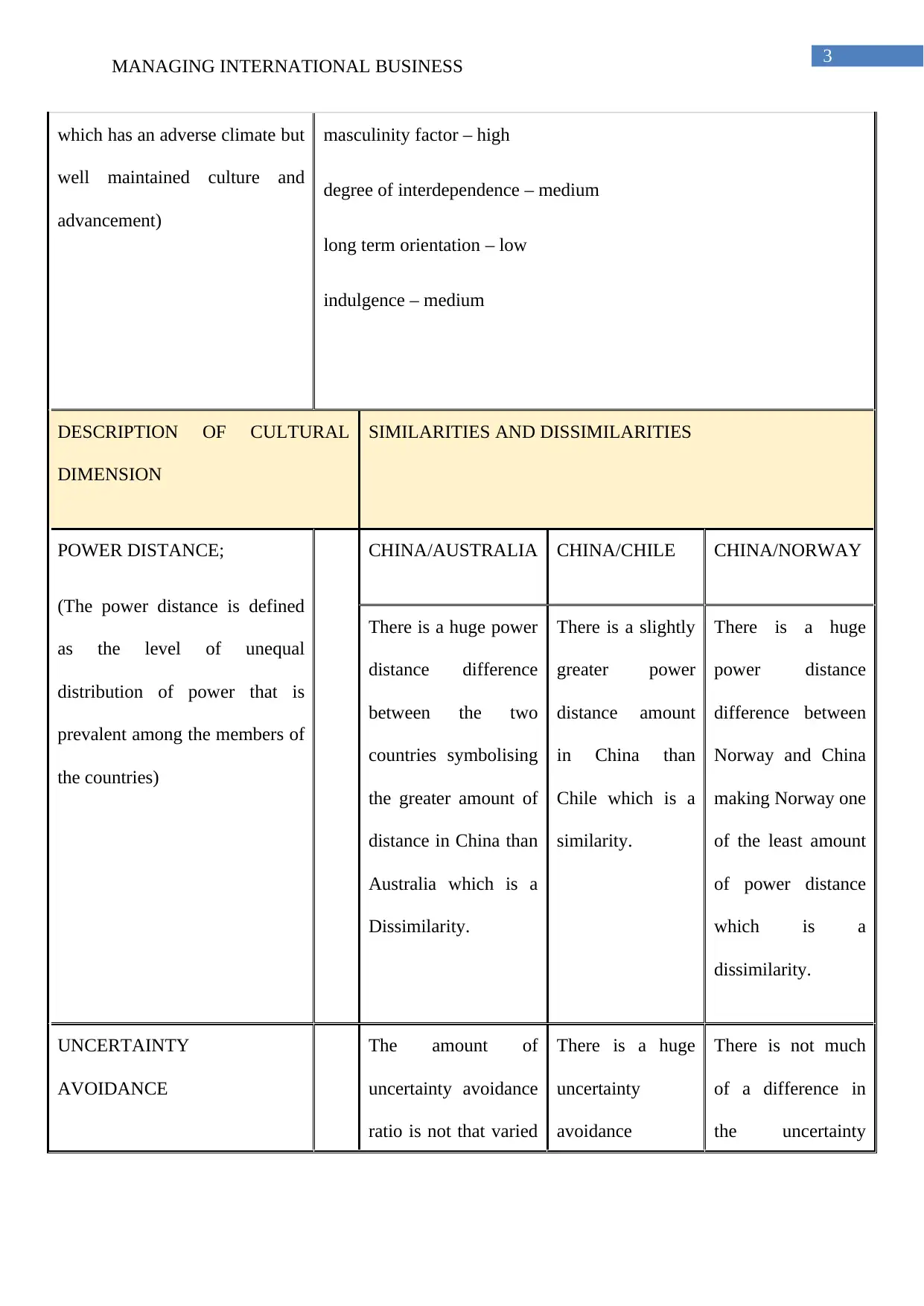
3
MANAGING INTERNATIONAL BUSINESS
which has an adverse climate but
well maintained culture and
advancement)
masculinity factor – high
degree of interdependence – medium
long term orientation – low
indulgence – medium
DESCRIPTION OF CULTURAL
DIMENSION
SIMILARITIES AND DISSIMILARITIES
POWER DISTANCE;
(The power distance is defined
as the level of unequal
distribution of power that is
prevalent among the members of
the countries)
CHINA/AUSTRALIA CHINA/CHILE CHINA/NORWAY
There is a huge power
distance difference
between the two
countries symbolising
the greater amount of
distance in China than
Australia which is a
Dissimilarity.
There is a slightly
greater power
distance amount
in China than
Chile which is a
similarity.
There is a huge
power distance
difference between
Norway and China
making Norway one
of the least amount
of power distance
which is a
dissimilarity.
UNCERTAINTY
AVOIDANCE
The amount of
uncertainty avoidance
ratio is not that varied
There is a huge
uncertainty
avoidance
There is not much
of a difference in
the uncertainty
MANAGING INTERNATIONAL BUSINESS
which has an adverse climate but
well maintained culture and
advancement)
masculinity factor – high
degree of interdependence – medium
long term orientation – low
indulgence – medium
DESCRIPTION OF CULTURAL
DIMENSION
SIMILARITIES AND DISSIMILARITIES
POWER DISTANCE;
(The power distance is defined
as the level of unequal
distribution of power that is
prevalent among the members of
the countries)
CHINA/AUSTRALIA CHINA/CHILE CHINA/NORWAY
There is a huge power
distance difference
between the two
countries symbolising
the greater amount of
distance in China than
Australia which is a
Dissimilarity.
There is a slightly
greater power
distance amount
in China than
Chile which is a
similarity.
There is a huge
power distance
difference between
Norway and China
making Norway one
of the least amount
of power distance
which is a
dissimilarity.
UNCERTAINTY
AVOIDANCE
The amount of
uncertainty avoidance
ratio is not that varied
There is a huge
uncertainty
avoidance
There is not much
of a difference in
the uncertainty
Secure Best Marks with AI Grader
Need help grading? Try our AI Grader for instant feedback on your assignments.

4
MANAGING INTERNATIONAL BUSINESS
(This is defined as the amount of
threat that is being felt by the
members of the social order due
to the sudden appearance of
threat in their lives and lifestyle)
in the two countries
meaning both the
countries being
affected by uncertain
situations which is a
similarity.
difference
between China
and Chile which
is a Dissimilarity.
avoidance between
China and Norway
which is similarity.
INDIVIDUALISM
(This is defined as the amount of
interdependence that is present
among the members of the social
order)
The level of
individualism is way
greater in Australia
than in China which is
a dissimilarity.
The level of
individualism in
on the same level
for both China
and Chile which
is a similarity.
There is a huge
difference of
individualism level
between China and
Norway which is a
Dissimilarity.
MASCULINITY
(This is defined as the amount of
motivation that is there in the
people of the country to be of
the male gender symbolising the
best or remain the female gender
symbolising their own existence
as they are)
The level of
masculinity is on the
same plane for both
China and Australia
which is a similarity.
There is a
moderately high
level of
masculinity
difference
between China
and Chile which
is a Dissimilarity.
There is a high level
of individualism
between China and
Norway which is a
Dissimilarity.
LONG TERM ORIENTATION The long term
orientation of China is
The long term
orientation of
The level of long
term orientation is
MANAGING INTERNATIONAL BUSINESS
(This is defined as the amount of
threat that is being felt by the
members of the social order due
to the sudden appearance of
threat in their lives and lifestyle)
in the two countries
meaning both the
countries being
affected by uncertain
situations which is a
similarity.
difference
between China
and Chile which
is a Dissimilarity.
avoidance between
China and Norway
which is similarity.
INDIVIDUALISM
(This is defined as the amount of
interdependence that is present
among the members of the social
order)
The level of
individualism is way
greater in Australia
than in China which is
a dissimilarity.
The level of
individualism in
on the same level
for both China
and Chile which
is a similarity.
There is a huge
difference of
individualism level
between China and
Norway which is a
Dissimilarity.
MASCULINITY
(This is defined as the amount of
motivation that is there in the
people of the country to be of
the male gender symbolising the
best or remain the female gender
symbolising their own existence
as they are)
The level of
masculinity is on the
same plane for both
China and Australia
which is a similarity.
There is a
moderately high
level of
masculinity
difference
between China
and Chile which
is a Dissimilarity.
There is a high level
of individualism
between China and
Norway which is a
Dissimilarity.
LONG TERM ORIENTATION The long term
orientation of China is
The long term
orientation of
The level of long
term orientation is
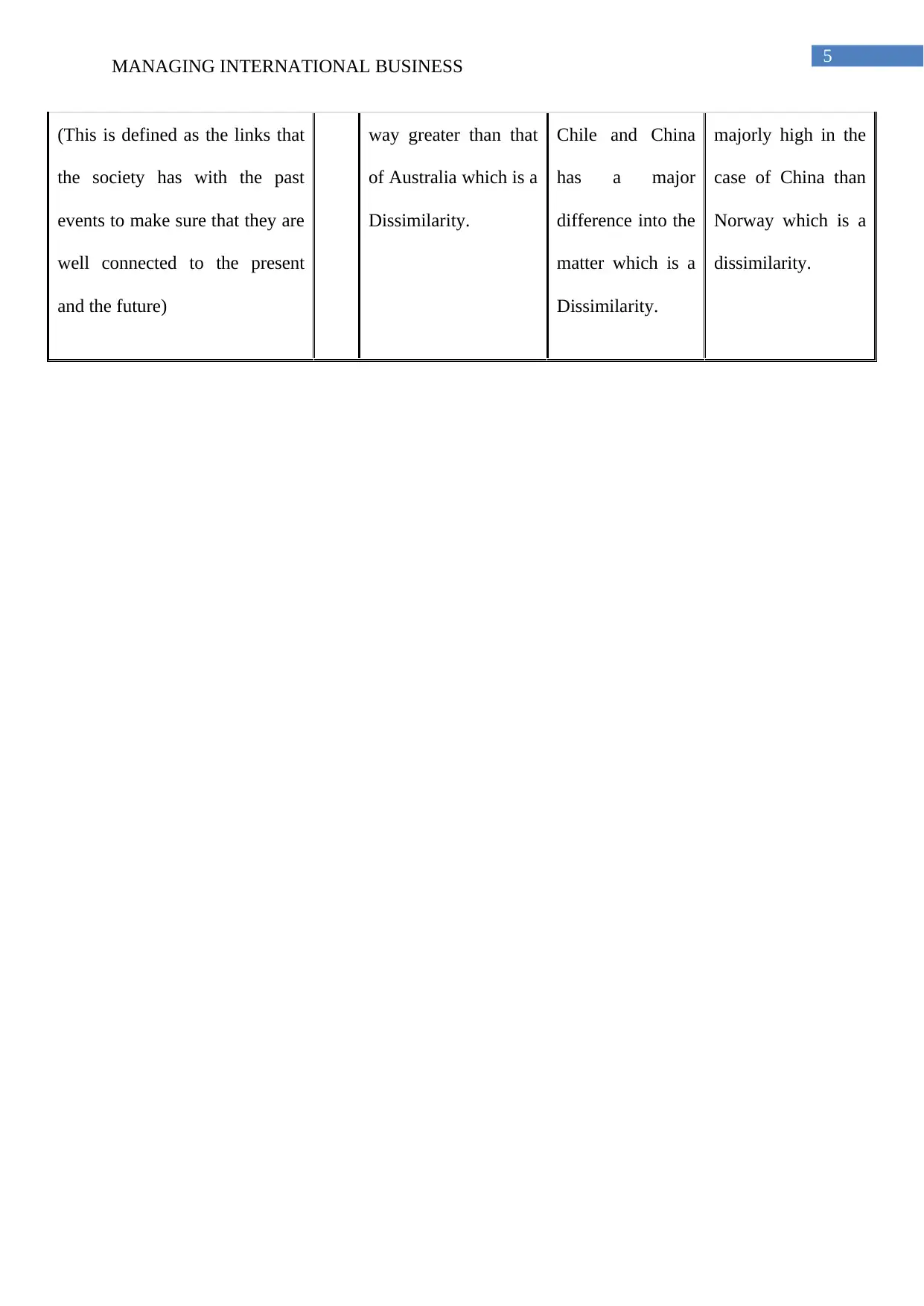
5
MANAGING INTERNATIONAL BUSINESS
(This is defined as the links that
the society has with the past
events to make sure that they are
well connected to the present
and the future)
way greater than that
of Australia which is a
Dissimilarity.
Chile and China
has a major
difference into the
matter which is a
Dissimilarity.
majorly high in the
case of China than
Norway which is a
dissimilarity.
MANAGING INTERNATIONAL BUSINESS
(This is defined as the links that
the society has with the past
events to make sure that they are
well connected to the present
and the future)
way greater than that
of Australia which is a
Dissimilarity.
Chile and China
has a major
difference into the
matter which is a
Dissimilarity.
majorly high in the
case of China than
Norway which is a
dissimilarity.
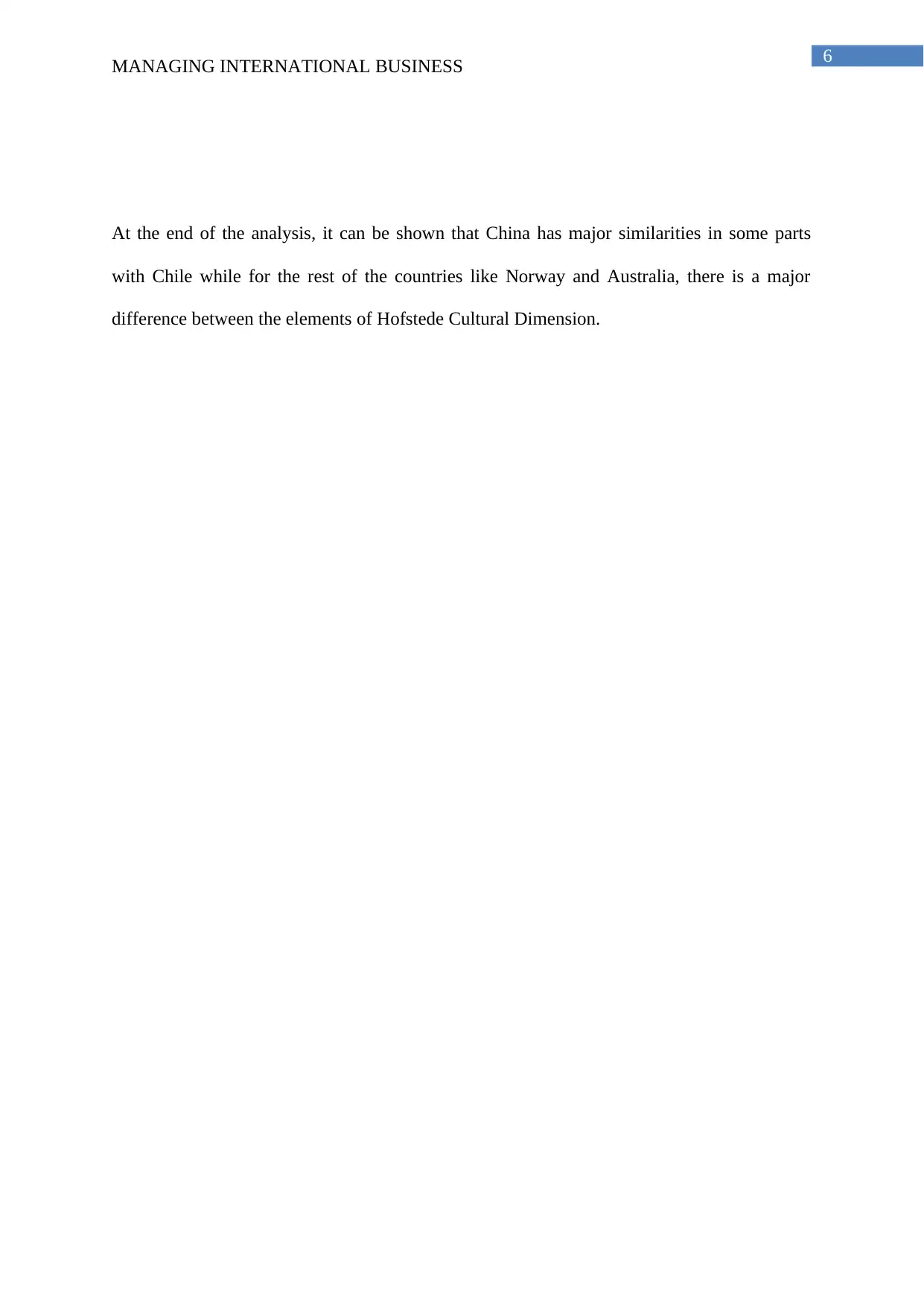
6
MANAGING INTERNATIONAL BUSINESS
At the end of the analysis, it can be shown that China has major similarities in some parts
with Chile while for the rest of the countries like Norway and Australia, there is a major
difference between the elements of Hofstede Cultural Dimension.
MANAGING INTERNATIONAL BUSINESS
At the end of the analysis, it can be shown that China has major similarities in some parts
with Chile while for the rest of the countries like Norway and Australia, there is a major
difference between the elements of Hofstede Cultural Dimension.
Paraphrase This Document
Need a fresh take? Get an instant paraphrase of this document with our AI Paraphraser
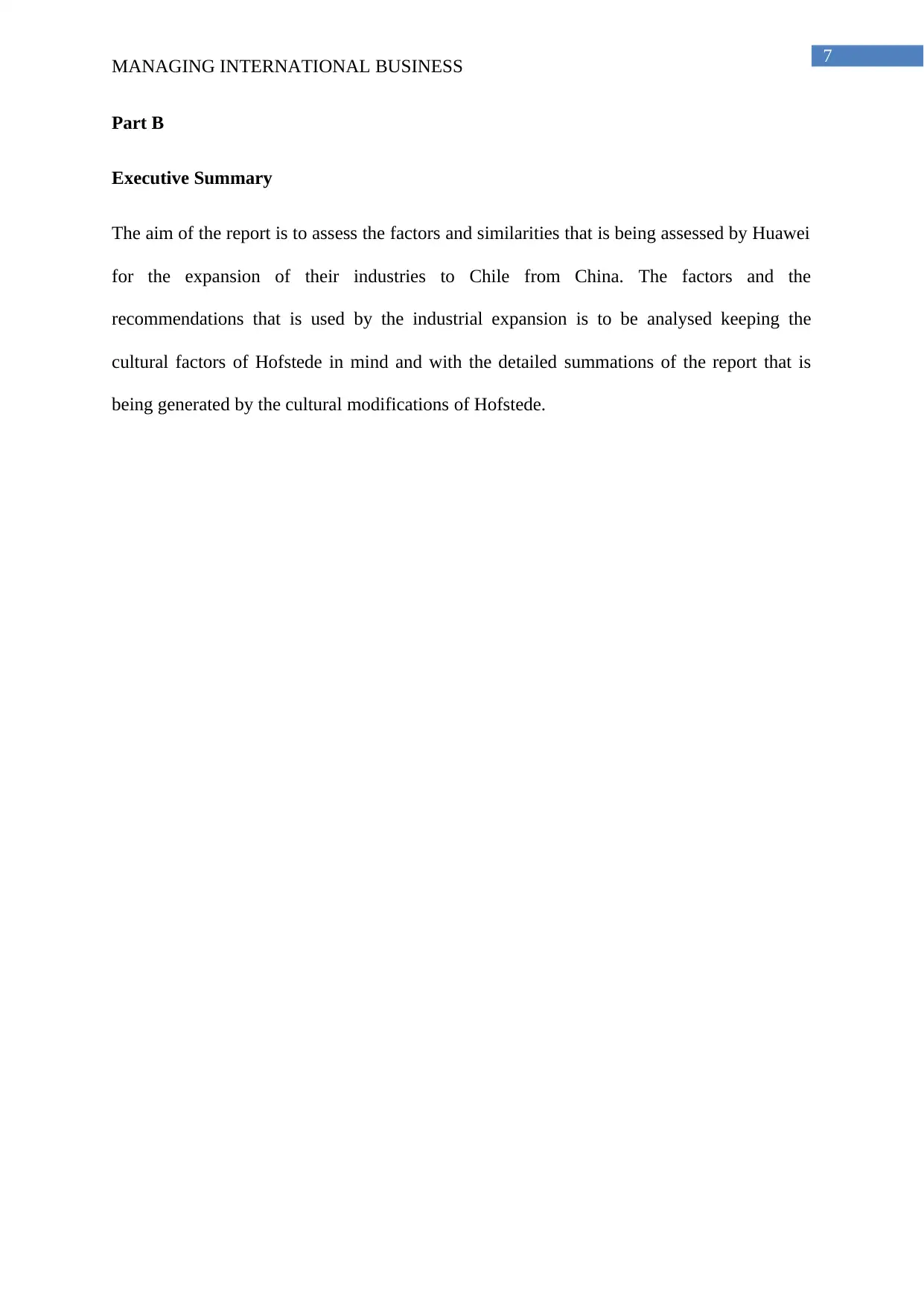
7
MANAGING INTERNATIONAL BUSINESS
Part B
Executive Summary
The aim of the report is to assess the factors and similarities that is being assessed by Huawei
for the expansion of their industries to Chile from China. The factors and the
recommendations that is used by the industrial expansion is to be analysed keeping the
cultural factors of Hofstede in mind and with the detailed summations of the report that is
being generated by the cultural modifications of Hofstede.
MANAGING INTERNATIONAL BUSINESS
Part B
Executive Summary
The aim of the report is to assess the factors and similarities that is being assessed by Huawei
for the expansion of their industries to Chile from China. The factors and the
recommendations that is used by the industrial expansion is to be analysed keeping the
cultural factors of Hofstede in mind and with the detailed summations of the report that is
being generated by the cultural modifications of Hofstede.
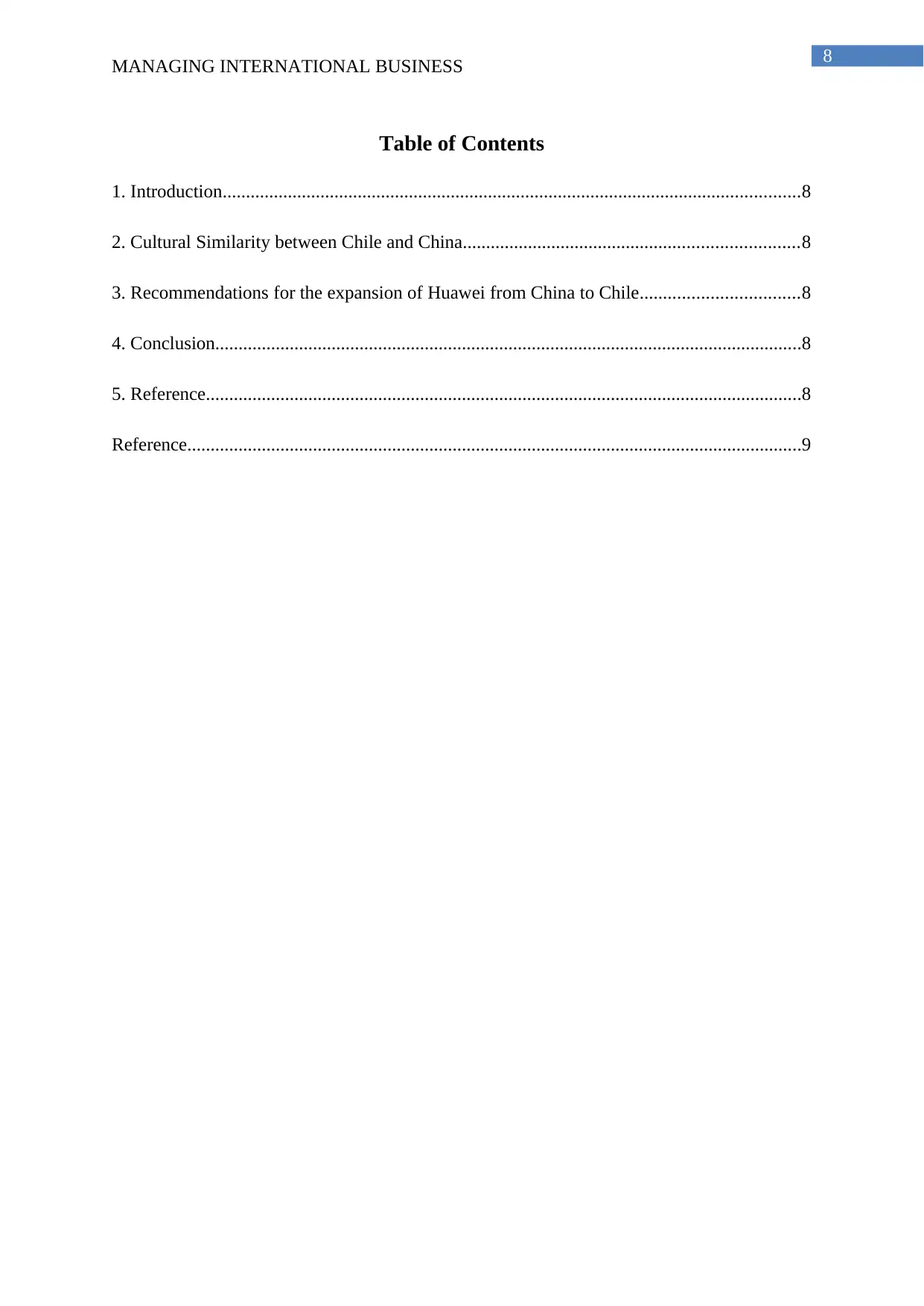
8
MANAGING INTERNATIONAL BUSINESS
Table of Contents
1. Introduction............................................................................................................................8
2. Cultural Similarity between Chile and China........................................................................8
3. Recommendations for the expansion of Huawei from China to Chile..................................8
4. Conclusion..............................................................................................................................8
5. Reference................................................................................................................................8
Reference....................................................................................................................................9
MANAGING INTERNATIONAL BUSINESS
Table of Contents
1. Introduction............................................................................................................................8
2. Cultural Similarity between Chile and China........................................................................8
3. Recommendations for the expansion of Huawei from China to Chile..................................8
4. Conclusion..............................................................................................................................8
5. Reference................................................................................................................................8
Reference....................................................................................................................................9
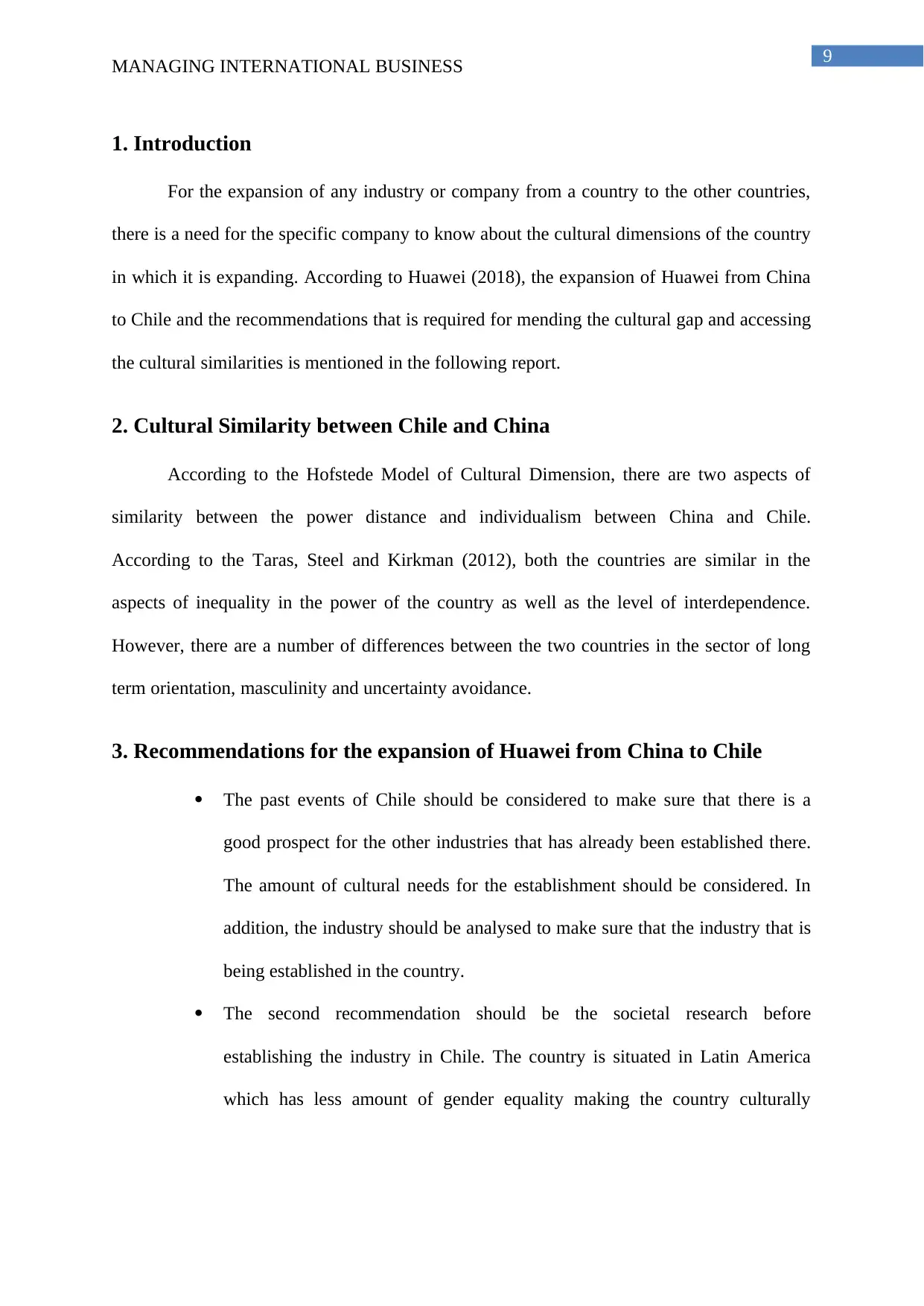
9
MANAGING INTERNATIONAL BUSINESS
1. Introduction
For the expansion of any industry or company from a country to the other countries,
there is a need for the specific company to know about the cultural dimensions of the country
in which it is expanding. According to Huawei (2018), the expansion of Huawei from China
to Chile and the recommendations that is required for mending the cultural gap and accessing
the cultural similarities is mentioned in the following report.
2. Cultural Similarity between Chile and China
According to the Hofstede Model of Cultural Dimension, there are two aspects of
similarity between the power distance and individualism between China and Chile.
According to the Taras, Steel and Kirkman (2012), both the countries are similar in the
aspects of inequality in the power of the country as well as the level of interdependence.
However, there are a number of differences between the two countries in the sector of long
term orientation, masculinity and uncertainty avoidance.
3. Recommendations for the expansion of Huawei from China to Chile
The past events of Chile should be considered to make sure that there is a
good prospect for the other industries that has already been established there.
The amount of cultural needs for the establishment should be considered. In
addition, the industry should be analysed to make sure that the industry that is
being established in the country.
The second recommendation should be the societal research before
establishing the industry in Chile. The country is situated in Latin America
which has less amount of gender equality making the country culturally
MANAGING INTERNATIONAL BUSINESS
1. Introduction
For the expansion of any industry or company from a country to the other countries,
there is a need for the specific company to know about the cultural dimensions of the country
in which it is expanding. According to Huawei (2018), the expansion of Huawei from China
to Chile and the recommendations that is required for mending the cultural gap and accessing
the cultural similarities is mentioned in the following report.
2. Cultural Similarity between Chile and China
According to the Hofstede Model of Cultural Dimension, there are two aspects of
similarity between the power distance and individualism between China and Chile.
According to the Taras, Steel and Kirkman (2012), both the countries are similar in the
aspects of inequality in the power of the country as well as the level of interdependence.
However, there are a number of differences between the two countries in the sector of long
term orientation, masculinity and uncertainty avoidance.
3. Recommendations for the expansion of Huawei from China to Chile
The past events of Chile should be considered to make sure that there is a
good prospect for the other industries that has already been established there.
The amount of cultural needs for the establishment should be considered. In
addition, the industry should be analysed to make sure that the industry that is
being established in the country.
The second recommendation should be the societal research before
establishing the industry in Chile. The country is situated in Latin America
which has less amount of gender equality making the country culturally
Secure Best Marks with AI Grader
Need help grading? Try our AI Grader for instant feedback on your assignments.
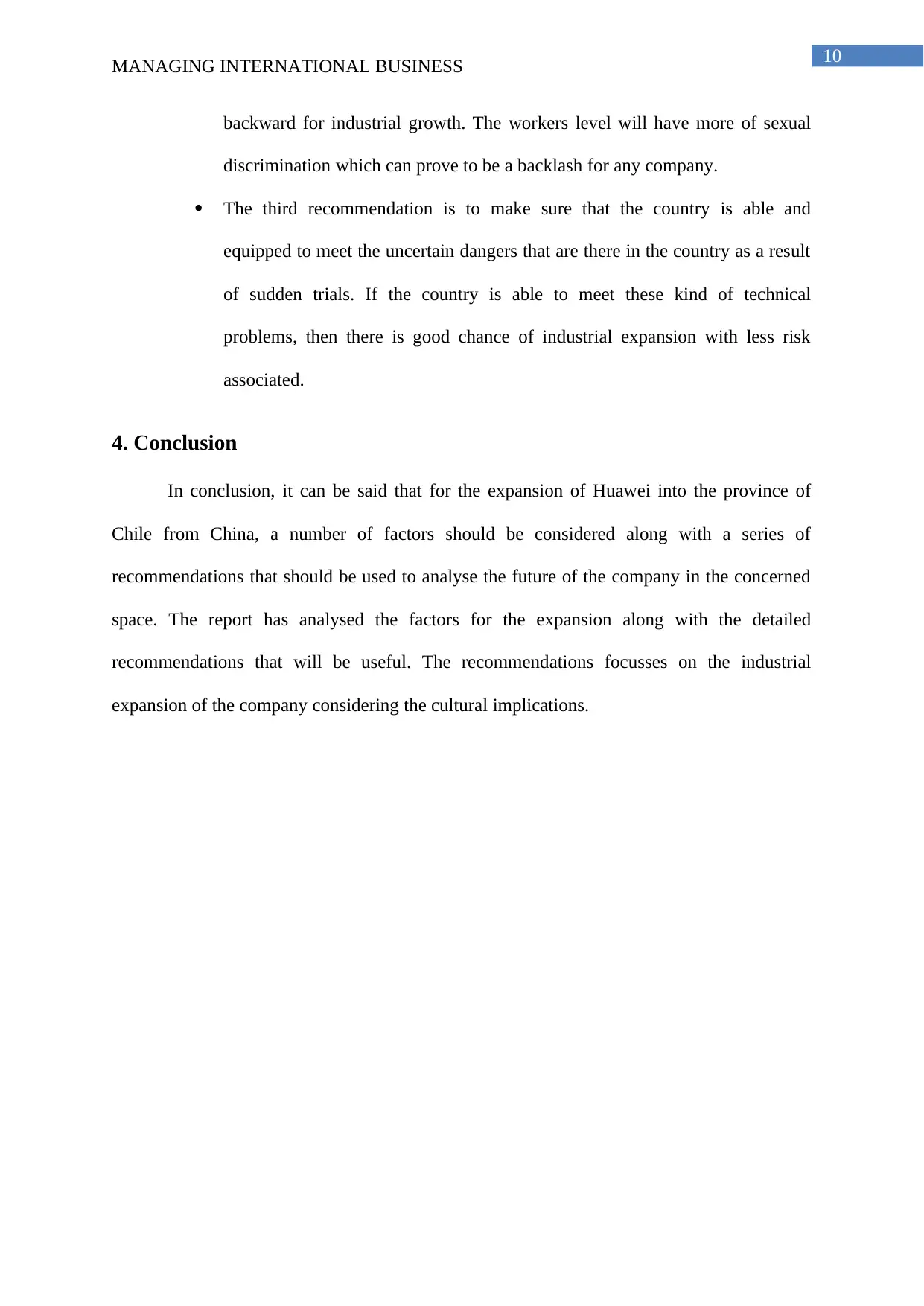
10
MANAGING INTERNATIONAL BUSINESS
backward for industrial growth. The workers level will have more of sexual
discrimination which can prove to be a backlash for any company.
The third recommendation is to make sure that the country is able and
equipped to meet the uncertain dangers that are there in the country as a result
of sudden trials. If the country is able to meet these kind of technical
problems, then there is good chance of industrial expansion with less risk
associated.
4. Conclusion
In conclusion, it can be said that for the expansion of Huawei into the province of
Chile from China, a number of factors should be considered along with a series of
recommendations that should be used to analyse the future of the company in the concerned
space. The report has analysed the factors for the expansion along with the detailed
recommendations that will be useful. The recommendations focusses on the industrial
expansion of the company considering the cultural implications.
MANAGING INTERNATIONAL BUSINESS
backward for industrial growth. The workers level will have more of sexual
discrimination which can prove to be a backlash for any company.
The third recommendation is to make sure that the country is able and
equipped to meet the uncertain dangers that are there in the country as a result
of sudden trials. If the country is able to meet these kind of technical
problems, then there is good chance of industrial expansion with less risk
associated.
4. Conclusion
In conclusion, it can be said that for the expansion of Huawei into the province of
Chile from China, a number of factors should be considered along with a series of
recommendations that should be used to analyse the future of the company in the concerned
space. The report has analysed the factors for the expansion along with the detailed
recommendations that will be useful. The recommendations focusses on the industrial
expansion of the company considering the cultural implications.
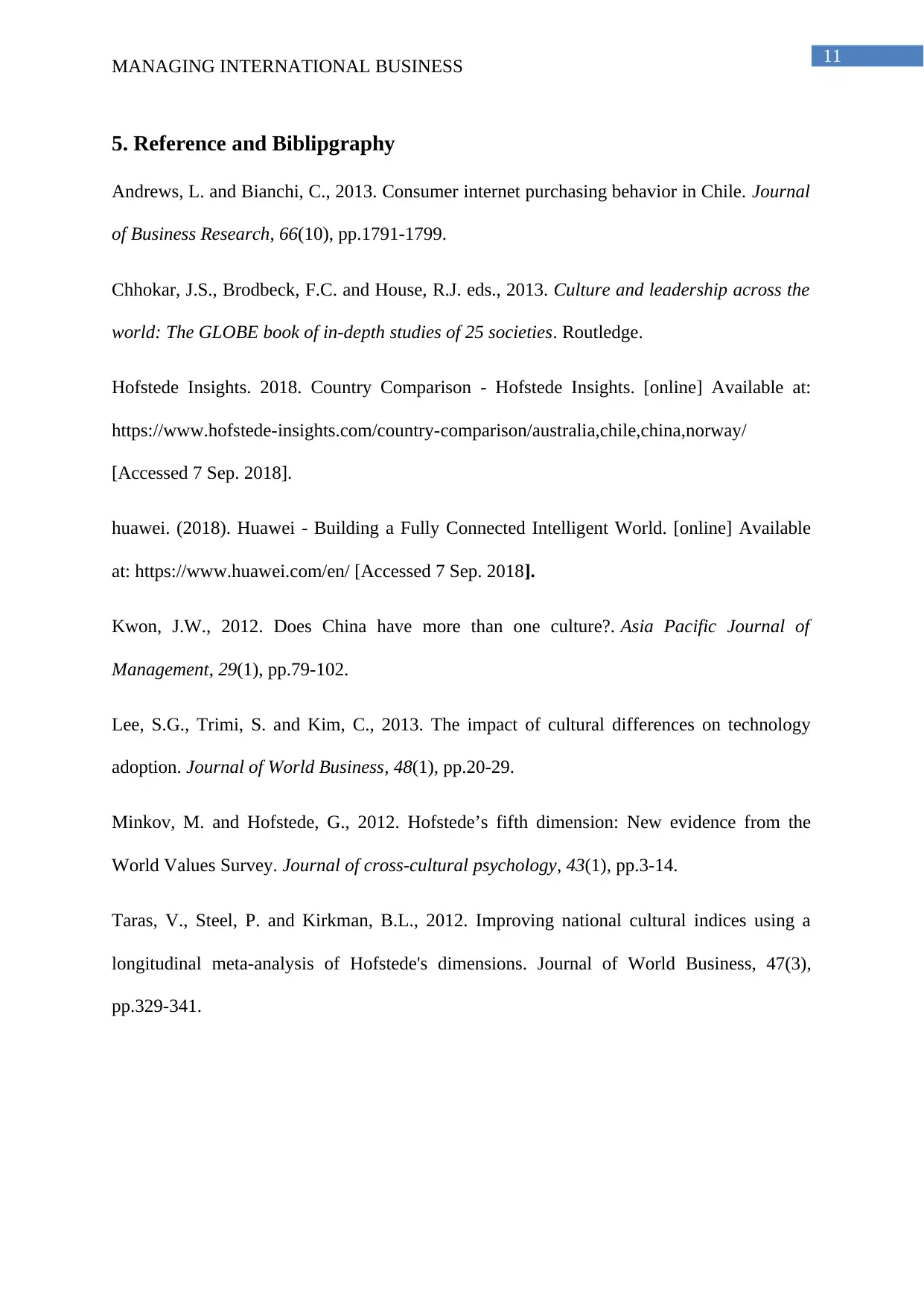
11
MANAGING INTERNATIONAL BUSINESS
5. Reference and Biblipgraphy
Andrews, L. and Bianchi, C., 2013. Consumer internet purchasing behavior in Chile. Journal
of Business Research, 66(10), pp.1791-1799.
Chhokar, J.S., Brodbeck, F.C. and House, R.J. eds., 2013. Culture and leadership across the
world: The GLOBE book of in-depth studies of 25 societies. Routledge.
Hofstede Insights. 2018. Country Comparison - Hofstede Insights. [online] Available at:
https://www.hofstede-insights.com/country-comparison/australia,chile,china,norway/
[Accessed 7 Sep. 2018].
huawei. (2018). Huawei - Building a Fully Connected Intelligent World. [online] Available
at: https://www.huawei.com/en/ [Accessed 7 Sep. 2018].
Kwon, J.W., 2012. Does China have more than one culture?. Asia Pacific Journal of
Management, 29(1), pp.79-102.
Lee, S.G., Trimi, S. and Kim, C., 2013. The impact of cultural differences on technology
adoption. Journal of World Business, 48(1), pp.20-29.
Minkov, M. and Hofstede, G., 2012. Hofstede’s fifth dimension: New evidence from the
World Values Survey. Journal of cross-cultural psychology, 43(1), pp.3-14.
Taras, V., Steel, P. and Kirkman, B.L., 2012. Improving national cultural indices using a
longitudinal meta-analysis of Hofstede's dimensions. Journal of World Business, 47(3),
pp.329-341.
MANAGING INTERNATIONAL BUSINESS
5. Reference and Biblipgraphy
Andrews, L. and Bianchi, C., 2013. Consumer internet purchasing behavior in Chile. Journal
of Business Research, 66(10), pp.1791-1799.
Chhokar, J.S., Brodbeck, F.C. and House, R.J. eds., 2013. Culture and leadership across the
world: The GLOBE book of in-depth studies of 25 societies. Routledge.
Hofstede Insights. 2018. Country Comparison - Hofstede Insights. [online] Available at:
https://www.hofstede-insights.com/country-comparison/australia,chile,china,norway/
[Accessed 7 Sep. 2018].
huawei. (2018). Huawei - Building a Fully Connected Intelligent World. [online] Available
at: https://www.huawei.com/en/ [Accessed 7 Sep. 2018].
Kwon, J.W., 2012. Does China have more than one culture?. Asia Pacific Journal of
Management, 29(1), pp.79-102.
Lee, S.G., Trimi, S. and Kim, C., 2013. The impact of cultural differences on technology
adoption. Journal of World Business, 48(1), pp.20-29.
Minkov, M. and Hofstede, G., 2012. Hofstede’s fifth dimension: New evidence from the
World Values Survey. Journal of cross-cultural psychology, 43(1), pp.3-14.
Taras, V., Steel, P. and Kirkman, B.L., 2012. Improving national cultural indices using a
longitudinal meta-analysis of Hofstede's dimensions. Journal of World Business, 47(3),
pp.329-341.
1 out of 12
Related Documents
Your All-in-One AI-Powered Toolkit for Academic Success.
+13062052269
info@desklib.com
Available 24*7 on WhatsApp / Email
![[object Object]](/_next/static/media/star-bottom.7253800d.svg)
Unlock your academic potential
© 2024 | Zucol Services PVT LTD | All rights reserved.




